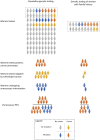Population Testing for High Penetrance Genes: Are We There Yet?
- PMID: 29401305
- PMCID: PMC6279254
- DOI: 10.1093/jnci/djx282
Population Testing for High Penetrance Genes: Are We There Yet?
Figures

Comment on
-
Cost-effectiveness of Population-Based BRCA1, BRCA2, RAD51C, RAD51D, BRIP1, PALB2 Mutation Testing in Unselected General Population Women.J Natl Cancer Inst. 2018 Jul 1;110(7):714-725. doi: 10.1093/jnci/djx265. J Natl Cancer Inst. 2018. PMID: 29361001
References
-
- US Preventive Services Task Force. USPSTF final recommendation statement BRCA-related cancer: Risk assessment, genetic counseling, and genetic testing. https://www.uspreventiveservicestaskforce.org/Page/Document/Recommendati... . Accessed November 16, 2017.
-
- Manchanda RSP, Gordeev VS, Antoniou AC et al. , . Cost-effectiveness of population-based BRCA1, BRCA2, RAD51C, RAD51D, BRIP1, PALB2 mutation-testing in unselected general-population women. J Natl Cancer Inst. 2018;1107:714–725. - PubMed
-
- Long EF, Ganz PA.. Cost-effectiveness of universal BRCA1/2 screening: Evidence-based decision making. JAMA Oncol. 2015;19:1217–1218.http://dx.doi.org/10.1001/jamaoncol.2015.2340 - DOI - PubMed
-
- Campeau PM, Foulkes WD, Tischkowitz MD.. Hereditary breast cancer: New genetic developments, new therapeutic avenues. Hum Genet. 2008;1241:31–42.http://dx.doi.org/10.1007/s00439-008-0529-1 - DOI - PubMed
Publication types
MeSH terms
Substances
LinkOut - more resources
Full Text Sources
Other Literature Sources
Research Materials
Miscellaneous

